‘Cultural Codes and Blurred Identity’
By Shira Wolfe
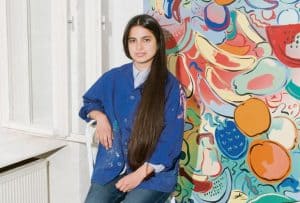
Berlin-based Venezuelan artist Sol Calero is interested in that tricky space of doubt that emerges when the references about one’s own identity become blurred. As a Venezuelan person who moved to Europe, she describes her situation like living in a surreal world – an amalgamation of memories of things that might not even exist anymore together with preconceived notions about her country of origin. That surreal world is what she tries to represent in her art. Important themes in Calero’s work are cultural codes and how they can take on different meanings over time, and her critique of tropical and Caribbean exoticisation.
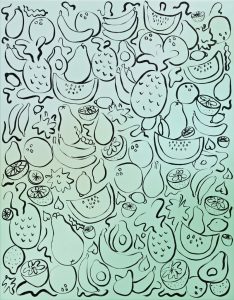
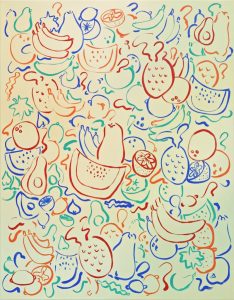
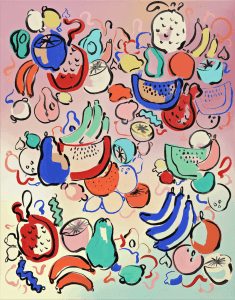
Sol Calero, Pintura de Frutas I, II and III (2014). Photo: Artuner
Calero’s art is vibrant, colourful, and deeply layered. She is passionate about researching Latin American art and the construction of identity in Latin American countries through appropriation of cultural symbols. Calero explains how complex this construction of identity really is. First of all, ‘Latin America’ is still often viewed and presented as a simplified package of all the countries that make up Latin America. Yet each country has its own specific history, cultural heritage, and identity. Calero’s Fruit Painting series smartly addresses this tendency towards simplification and generalisation. The paintings are filled with colourful fruit and flowers, a mixture of stereotypes and symbols from different Latin American countries. This simplification mirrors back the Western viewer’s own simplifying tendencies.

In a ‘Terremoto’ article, Calero talks about Venezuela’s relationship to its own history, one that is very different from nearby countries such as Mexico. Since Pre-Colombian Venezuela was mostly inhabited by nomadic tribes who left little trace of their existence, Venezuela did not have the visual markers upon which to construct a visual identity. What happened was that Venezuela built its visual identity on representations of the Caribbean, becoming extremely exocitised. It also started recycling cultural symbols that had been appropriated in the first place, adopting them as part of their culture. Calero is all about pointing out these issues and ironies with her work, but she likes to do it with a touch of lightness – the history and present of her home country may be heavy and painful, but she believes there is power in engaging with this in a way that is not too literal and dramatic.
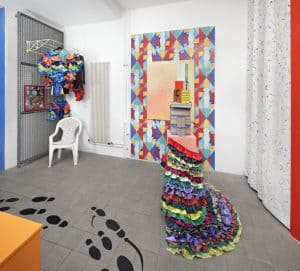
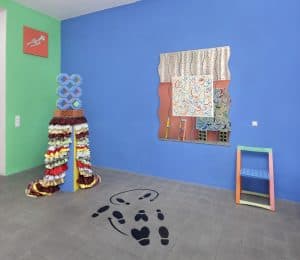
Installation view, ‘Project Salsa’ (2014). Photo: Gillmeier Rech
Calero’s artistic practice encompasses a wide range of media – painting, drawing, found objects, fabric, and more site-based projects mixing paintings with design. The artist always aims at creating a social space – she speaks of ‘breaking the white space’, turning the gallery space into a welcoming space where people feel comfortable and can interact on a social level. In that spirit, she often designs the entire space of her exhibition, allowing her paintings to interact with other objects in the space. It’s about creating a space for spontaneity and exchange. In one such project, she redecorated a Berlin salsa school and organised free dance classes there (Project Salsa, 2014). The entire space was saturated with Calero’s art, and the project also raised questions concerning cultural appropriation and exoticisation, while focusing on the social and spontaneous elements that are so important to her.
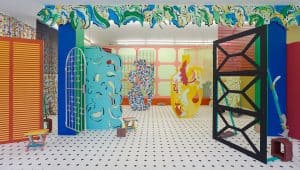
In her 2017 exhibition ‘Interiores’ at Dortmunder Kunstverein, she also played with this full three-dimensional transformation of the ‘white box’ gallery space. The floor-to-ceiling world of Calero gives the feeling that the viewer has stepped into one of her paintings, into her surreal world where she deftly takes on complex issues such as cultural appropriation and stereotyping. Besides her many exhibitions, Calero also runs a project space called Kinderhook & Caracas together with Christopher Kline. The space is named after the two artists’ hometowns. They organise and host numerous artistic projects and have published several art publications.
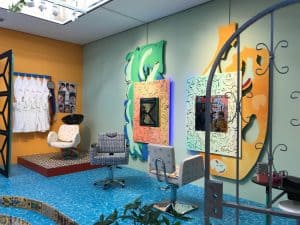
Calero was a finalist in the Preis der Nationalgalerie 2017 competition, and was voted the public’s favourite for her installation Amazonas Shopping Center. This was a retrospective, fully immersive installation of her most recent projects, inspired by a little storefront she came across in South London, full of small Latino businesses.
The artist has a busy year ahead. Catch her at the following 2018 exhibitions:
Barbara Gross, Munich
July 2018
Kunstverein Düsseldorf, Düsseldorf
31 August – 28 October 2018
Sensory Spaces, Museum Boijmans Van Beuningen, Rotterdam
13 October 2018 – January 2019
Galerie Crèvecoeur, Paris
18 October 2018
ACCA, Melbourne
14 December 2018